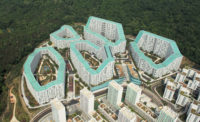Welcome to the Animal House


















Designer shelters for the birds and the bees elevate our view of food production.
A Modernist roost for a chicken? A bespoke cow barn on an English country estate? A luxury high-rise for a colony of bees? Some people might say that these structures are unnecessarily extravagant, given the simple programmatic needs of the occupants. But, as architect Stephen Taylor says of the barn he designed at Shatwell Farm in Somerset, England, that responds to the dignified, centuries-old architecture around it: “Every building is always part of something bigger.” While it was a growing interest in urban farming that led to the proliferation of backyard chicken coops, the trend's latest wave has upped the ante with features like solar-powered LEDs and green roofs. “As architects we try to think of things a little differently, and, for example, elevate the pigsty to another level,” says Keith Moskow, one of the Boston architects behind Rolling Pig Pen. “Whether for a person or a pig, we are always asking how we can make an experience better,” adds his partner, Robert Linn. Grabbing attention also increases the value of these shelters as teaching tools, much as the Elevator B beehive has generated awareness of the crisis of the declining honeybee population known as colony-collapse disorder and its larger implications for the ecosystem. The vogue of rejecting industrialized food production and celebrating authenticity and pedigree took hold a generation ago, and continues to evolve. Structures like these—whether motivated by grassroots activism or the current zeitgeist—encapsulate this particular moment in time.














